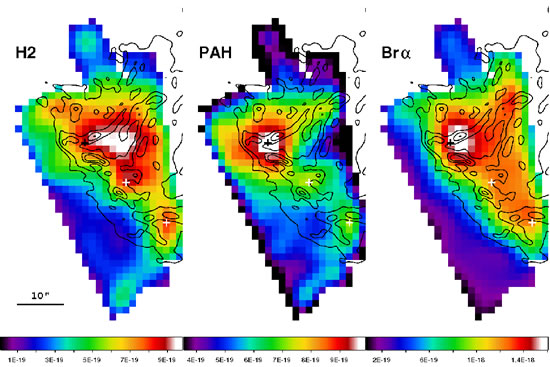Research Gallery > Interstellar and Circumstellar Medium
Research Gallery
Interstellar and Circumstellar Medium
| Molecular hydrogen, PAH, and Bralpha line maps of SNR N49 in the Large Magellanic Cloud |
|
Image Credit: Seok et al.

H2 1–0 O(3), PAH, and Brα line maps of N49 by using the AKARI/IRC spectra. For comparison, contours (black) are taken from an Hα image of the
HST/WFPC2 (Bilikova et al. 2007); these contours are 10%, 30%, 50%, and 70% of the peak. The black crossmarks the peak of the PAH emission at (α2000, δ2000)= (05h26m05.s14,−66d05'03"). The white crosses denote two clumps seen in the PAH line map. The scale bar represents 10" or 2.4 pc at 50 kpc. The color bars are given in units of W m−2 arcsec−2. North is up and east is to the left.
|
| Three line maps show the enhanced emission at the
eastern region. Previous observations at the other wavelengths similarly show the brightness enhancement, which is interpreted as the effect of the interaction between the SNR and the nearby molecular cloud at the southeast (Banas et al. 1997; Bilikova et al. 2007). The morphology of the PAH emission, however, has similarities and differences in details with respect to those of the H2 O(3) and Brα emissions. The eastern boundaries of both the H2 and PAH emissions are indented with respect to the Hα boundary (e.g., a gap at the eastern side between the two white crosses), while the Brα emission is in good agreement with it. In particular, it is noticeable that both H2 and PAH exceed the Hα boundary around the tip of the wedge-shaped region, which is at the center of the interacting molecular cloud. The two clumps of the PAH emission in the south (white crosses) could be seen at the coincident positions in the H2 map. Meanwhile, the peak position of the PAH emission is not matched with that of the H2 emission but rather closer to that of the Brα emission. In addition, it is interesting that the relatively weak PAH emission is observed where the H2 emission is the strongest. |
 asiaa.sinica.edu.tw Media Request: epo
asiaa.sinica.edu.tw Media Request: epo asiaa.sinica.edu.tw
asiaa.sinica.edu.tw 
